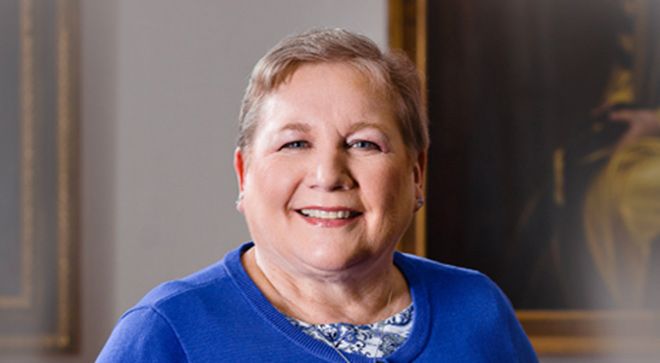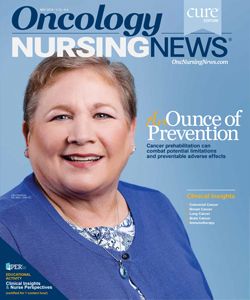An Ounce of Prevention: Cancer Prehabilitation
Cancer prehabilitation can combat potential limitations and preventable adverse effects.

"The goal of prehabilitation is to prevent [patients] from getting to the point of needing reconditioning," says Lillie Shockney, RN, MAS, ONN-CG.
Today, a cancer diagnosis does not mean a patient’s life is over, but it does mean things may get more difficult for that individual. Despite knowing that many patients with cancer will survive the disease, much of the medical focus is still on the acute-care phase and less on what comes before or after.
Prehabilitation is a growing service in many cancer centers that helps patients prepare for acute care and long-term survivorship. It enables the care team to consider what will change in patients’ lives because of treatment and how the team can help them face those changes.
Nurses and nurse navigators play a significant role in advocating for prehabilitation and other services that can help preserve patients’ quality of life.
WHAT IS PREHABILITATION?
Prehabilitation is an evidence-based process that occurs in the time between diagnosis and the start of acute care. The goal is to prepare a patient with cancer as much as possible, in whatever ways necessary, for surgery, chemotherapy, or radiation. This process may include physical, social, emotional, or environmental interventions.
Julie Silver, MD, associate chair for strategic initiatives in the Department of Physical Medicine and Rehabilitation at Harvard Medical School, is credited as the founder of prehabilitation. She established the Survivorship Training and Rehabilitation (STAR) Program in 2009, partly because of her own experiences with breast cancer in 2003, and advocates for more adoption of metricsdriven prehab programs.
In a 2013 interview with NPR, Silver shared with listeners that she wished she had been more prepared for what was to come during her own illness and had known what she could have done to help ensure the best possible outcomes. She noted that when she did exercise testing after breast cancer treatment, her results indicated she was in her 60s. She was 38 at the time.
“I had aged 3 decades in a matter of months through cancer treatment.”1 The STAR model includes 5 components to prepare patients for cancer treatment: smoking cessation, general exercise, targeted exercise, nutrition, and stress reduction.2 Interventions in the model are time-based and thoroughly documented to track effectiveness.
Lillie Shockney, RN, MAS, ONN-CG, director of cancer survivorship programs at the Sidney Kimmel Comprehensive Cancer Center at Johns Hopkins University, is another strong advocate for prehabilitation. She estimates that more than half of cancer centers in the United States have some form of prehabilitation program. With increased awareness, she hopes that more programs can be added—or, at least, that more patients can be referred to services.
“Rather than waiting for a patient to become physically debilitated by cancer treatment and then be reconditioned, the goal of prehabilitation is to prevent them from getting to the point of needing reconditioning,” she said. Shockney noted that prehab at Johns Hopkins is divided into two categories. The first is referrals to the appropriate prehabilitation services, whether physical therapy, occupational therapy, or at-home exercises to increase the patient’s strength or to learn important exercises before treatment. The second is steps taken to safeguard patients’ life goals.
The second category involves taking the time to understand what’s important to the patient. For example, one of Shockney’s patients loved playing the piano and dreamed of becoming a concert pianist, but her proposed treatment could have caused peripheral neuropathy, potentially ending her dream. As her navigator, Shockney intervened to ask for a different chemotherapy. Understanding such life goals helps nurses work with the care team to prepare patients to maintain functioning or choose other treatment options.
FORMS OF PREHABILITATION
Exercises or physical activity of some kind are common components of prehabilitation. For example, physical therapy can be used to help reduce or prevent lymphedema.
“Part of recovery means being physically fit before treatment starts,” Shockney said. “In the case of lymphedema, beginning arm exercises and learning do’s and don’ts before surgery is a better way to prevent it. Without this preparation, [the patient] may already have done some things that raise her risk of getting lymphedema before she enters rehabilitation. That can be prevented.”
Like Silver, Shockney became an advocate because of her own experiences with a breast cancer diagnosis 26 years ago. After undergoing her first mastectomy, the cancer then was diagnosed in her other breast, ultimately leading to a second mastectomy. For medical reasons, Shockney wasn't able to do reconstruction until 10 years after her second mastectomy when she decided to undergo deep inferior epigastric perforator (DIEP) flap reconstruction, which would transplant belly fat to her chest. Because she knew that having more core strength would help her recover faster, Shockney began physical therapy 6 weeks before the surgery, with the goal of shortening her time in the hospital.
“Back then, most patients who had this surgery stayed in the hospital 4 to 5 days,” she said. “I was the first to go home at 3 days. Now the average stay is 3 nights. People go home on day 4, in part because they are starting prehab to strengthen their core before surgery.”
Prehabilitation may also teach someone to use an incentive spirometer or do exercises to prevent blood clots. This allows patients to immediately begin their recovery after treatment, rather than waiting to be taught or having a steep learning curve after surgery.
HOW NURSES CAN BE PREHAB ADVOCATES
Nurses and nurse navigators are on the frontline of patient care. They’re the ones learning what matters most to patients and advocating for their values. Alene Nitzky, PhD, RN, OCN, an oncology nurse, personal trainer, and author of the book Navigating the C: A Nurse Charts the Course for Cancer Survivorship Care, is also an advocate for prehabilitation and preparing for cancer treatment in general. She founded Cancer Harbors, a center in Colorado that focuses solely on survivorship care after acute treatment. The patients she sees may have struggles or limitations they will deal with for years after they’ve gone into remission.
“I work with people after treatment, and I find that they don’t get the information they’re going to need before they go through treatment,” she said. “There’s physical preparation, but also emotional, social, mental, and environmental.”
That’s why she advocates for preparation by patients, doctors, nurses, and others. This includes staying or becoming more physically fit and healthier overall, entering a prehabilitation program to get prepared for a specific treatment, or getting resources in place to handle the disruptions cancer will cause to daily life.
“The better condition your body is in before you go into any kind of treatment, the better off you’ll be,” she said. “You’ll tolerate treatment better, heal faster, and recover better.”
Nurses can help patients get referrals and find services. Nitzky and Shockney both pointed out that, although there are exceptions, most patients don’t need to rush into treatment. Many people can wait a few weeks for prehab recommendations and to start them before treatment begins. “Time is something the medical community doesn’t explain very well,” Nitzky said. “Generally, people have time to absorb information, get a second opinion, and start prehab.”
Nurses can request that patients be referred to physical, speech, or occupational therapies or to other interventions that may prepare them to undergo treatment. Nurses are the key advocates for getting patients into prehab. They can identify patients and refer them to the proper services by asking the right questions, such as: • What are this patient’s activities of daily living? • Will the patient be able to do those activities independently after treatment? • What resources will the patient need after treatment? • What are the patient’s goals and interests? • Can the proposed treatment impair the patient’s ability to do those things? • Is there an alternative treatment? • What is the patient’s baseline health functioning? • Is there an intervention the patient can do in advance to reduce the chances of impairment? • What strengthening or lifestyle interventions would help the patient better tolerate treatment?
Nurses and nurse navigators are the most likely team members to be asking these questions. They know the patients personally, understand their daily activities, and know what parts of the patients’ bodies will be disrupted by treatment. “Doctors aren’t making the referrals, and patients don’t know to ask for them,” Nitzky said. “There’s where nurses can help.”
DOES PREHAB WORK?
Early research finds that prehabilitation may improve patients’ physical and psychological outcomes. Providers need to determine a patient’s baseline physical function at the time of diagnosis and then extrapolate the possible burdens treatment may add. For example, if a patient loves to compete in 5Ks and has radiation scheduled, focus on exercises to help him maintain some level of physical activity during treatment. If a patient stocks shelves as part of her work duties before undergoing a mastectomy, it is important that she strengthen her upper body and begin preventing lymphedema before surgery. Choosing interventions known to address potential limitations from treatment may reduce complications, length of stay, readmissions, and severity of impairments, according to research published by Silver.3
COST AND COVERAGE
There’s not a lot of formal research specifically on the cost savings from prehabilitation programs. Cost is a concern for providers and patients, but because interventions are evidence-based, insurance coverage hasn’t been a problem. Prehabilitation doesn’t have a specific billing code, but each individual service is usually covered. For example, it’s well known that patients need to stop smoking, so smoking cessation is included in cancer care.
Nutrition is also a common intervention in most programs because it’s understood that specific eating habits need to change, especially in patients with particular cancer types. Patients have a certain number of covered rehabilitation sessions that can be used before treatment rather than after. Plus, some interventions, like walking or a general increase in physical activity, can be done by patients at home for free. And studies have found that walking programs reduce fatigue for people undergoing radiation.
Many cancer centers offer services to prepare patients for treatment; however, formal research on the outcomes of prehabilitation are still limited. Silver’s STAR Program is time-based, evidence-based, and has measurable goals, so she and others involved with STAR are actively working to contribute to the growing body of research about prehabilitation.
The growth of formal programs that document prehabilitation interventions and outcomes will also help add to the research in this arena. In today’s metrics-driven healthcare environment, implementing these interventions and documenting them will be key to increasing adoption and payment.
Shockney points out that even without formal evidence, prehabilitation is just common sense. “For prehab, a lightbulb went off and we said, ‘Why are we allowing patients to become physically deconditioned when we can maintain physical activity during treatment?’” she said. “I’m not sure why it took so long, but it did.”
Whether a cancer center has a formal prehab program or not, nurses are still poised to suggest referrals to these types of services for patients who would benefit the most.
REFERENCES
- Gotbaum R. Cancer rehab begins to bridge a gap to reach patients. National Public Radio. npr.org/sections/health-shots/2013/02/18/172099043/cancer-rehab-begins-to-bridge-a-gap-to-reach-patients. Published February 18, 2013. Accessed March 6, 2018. 2.
- Silver J. Cancer prehabilitation: important lessons from a best practices model. J Hematol Oncol Pharm. 2015;8(2). jhoponline.com/ton-issue-archive/2015-issues/march-vol-8-no-2/16357-cancer-prehabilitation-important-lessons-from-a-best-practices-model. Accessed March 6, 2018.
- Silver J. Cancer prehabilitation and its role in improving health outcomes and reducing health care costs. Semin Oncol Nurs. 2015;31(1):13-30. doi: 1016/j.soncn.2014.11.003.

Innovative Program Reduces Nurse Turnover and Fosters Development
Published: September 12th 2024 | Updated: September 12th 2024The US Oncology Network (The Network) has developed one of the most comprehensive programs in the nation to support the professional development and retention of new oncology nurses.


